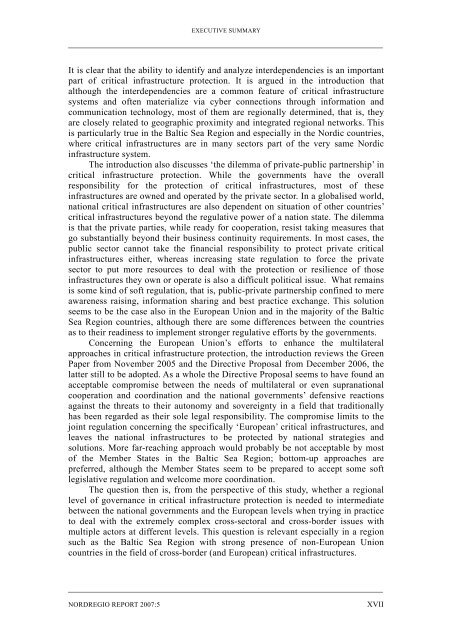Towards a Baltic Sea Region Strategy in Critical ... - Helsinki.fi
Towards a Baltic Sea Region Strategy in Critical ... - Helsinki.fi
Towards a Baltic Sea Region Strategy in Critical ... - Helsinki.fi
Create successful ePaper yourself
Turn your PDF publications into a flip-book with our unique Google optimized e-Paper software.
EXECUTIVE SUMMARY<br />
It is clear that the ability to identify and analyze <strong>in</strong>terdependencies is an important<br />
part of critical <strong>in</strong>frastructure protection. It is argued <strong>in</strong> the <strong>in</strong>troduction that<br />
although the <strong>in</strong>terdependencies are a common feature of critical <strong>in</strong>frastructure<br />
systems and often materialize via cyber connections through <strong>in</strong>formation and<br />
communication technology, most of them are regionally determ<strong>in</strong>ed, that is, they<br />
are closely related to geographic proximity and <strong>in</strong>tegrated regional networks. This<br />
is particularly true <strong>in</strong> the <strong>Baltic</strong> <strong>Sea</strong> <strong>Region</strong> and especially <strong>in</strong> the Nordic countries,<br />
where critical <strong>in</strong>frastructures are <strong>in</strong> many sectors part of the very same Nordic<br />
<strong>in</strong>frastructure system.<br />
The <strong>in</strong>troduction also discusses ‘the dilemma of private-public partnership’ <strong>in</strong><br />
critical <strong>in</strong>frastructure protection. While the governments have the overall<br />
responsibility for the protection of critical <strong>in</strong>frastructures, most of these<br />
<strong>in</strong>frastructures are owned and operated by the private sector. In a globalised world,<br />
national critical <strong>in</strong>frastructures are also dependent on situation of other countries’<br />
critical <strong>in</strong>frastructures beyond the regulative power of a nation state. The dilemma<br />
is that the private parties, while ready for cooperation, resist tak<strong>in</strong>g measures that<br />
go substantially beyond their bus<strong>in</strong>ess cont<strong>in</strong>uity requirements. In most cases, the<br />
public sector cannot take the f<strong>in</strong>ancial responsibility to protect private critical<br />
<strong>in</strong>frastructures either, whereas <strong>in</strong>creas<strong>in</strong>g state regulation to force the private<br />
sector to put more resources to deal with the protection or resilience of those<br />
<strong>in</strong>frastructures they own or operate is also a dif<strong>fi</strong>cult political issue. What rema<strong>in</strong>s<br />
is some k<strong>in</strong>d of soft regulation, that is, public-private partnership conf<strong>in</strong>ed to mere<br />
awareness rais<strong>in</strong>g, <strong>in</strong>formation shar<strong>in</strong>g and best practice exchange. This solution<br />
seems to be the case also <strong>in</strong> the European Union and <strong>in</strong> the majority of the <strong>Baltic</strong><br />
<strong>Sea</strong> <strong>Region</strong> countries, although there are some differences between the countries<br />
as to their read<strong>in</strong>ess to implement stronger regulative efforts by the governments.<br />
Concern<strong>in</strong>g the European Union’s efforts to enhance the multilateral<br />
approaches <strong>in</strong> critical <strong>in</strong>frastructure protection, the <strong>in</strong>troduction reviews the Green<br />
Paper from November 2005 and the Directive Proposal from December 2006, the<br />
latter still to be adopted. As a whole the Directive Proposal seems to have found an<br />
acceptable compromise between the needs of multilateral or even supranational<br />
cooperation and coord<strong>in</strong>ation and the national governments’ defensive reactions<br />
aga<strong>in</strong>st the threats to their autonomy and sovereignty <strong>in</strong> a <strong>fi</strong>eld that traditionally<br />
has been regarded as their sole legal responsibility. The compromise limits to the<br />
jo<strong>in</strong>t regulation concern<strong>in</strong>g the speci<strong>fi</strong>cally ‘European’ critical <strong>in</strong>frastructures, and<br />
leaves the national <strong>in</strong>frastructures to be protected by national strategies and<br />
solutions. More far-reach<strong>in</strong>g approach would probably be not acceptable by most<br />
of the Member States <strong>in</strong> the <strong>Baltic</strong> <strong>Sea</strong> <strong>Region</strong>; bottom-up approaches are<br />
preferred, although the Member States seem to be prepared to accept some soft<br />
legislative regulation and welcome more coord<strong>in</strong>ation.<br />
The question then is, from the perspective of this study, whether a regional<br />
level of governance <strong>in</strong> critical <strong>in</strong>frastructure protection is needed to <strong>in</strong>termediate<br />
between the national governments and the European levels when try<strong>in</strong>g <strong>in</strong> practice<br />
to deal with the extremely complex cross-sectoral and cross-border issues with<br />
multiple actors at different levels. This question is relevant especially <strong>in</strong> a region<br />
such as the <strong>Baltic</strong> <strong>Sea</strong> <strong>Region</strong> with strong presence of non-European Union<br />
countries <strong>in</strong> the <strong>fi</strong>eld of cross-border (and European) critical <strong>in</strong>frastructures.<br />
NORDREGIO REPORT 2007:5<br />
XVII

















